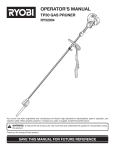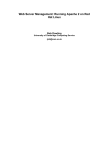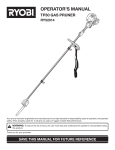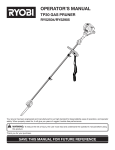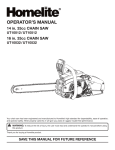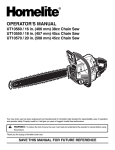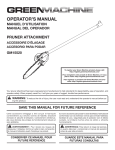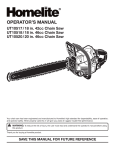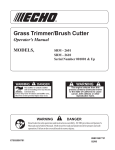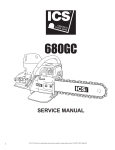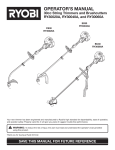Download OPERATOR`S MANUAL - Pdfstream.manualsonline.com
Transcript
OPERATOR’S MANUAL PC30 PRUNER/TRIMMER RY52002 Your pruner/trimmer has been engineered and manufactured to Ryobi’s high standard for dependability, ease of operation, and operator safety. When properly cared for, it will give you years of rugged, trouble-free performance. WARNING: To reduce the risk of injury, the user must read and understand the operator’s manual before using this product. Thank you for buying a Ryobi product. SAVE THIS MANUAL FOR FUTURE REFERENCE TABLE OF CONTENTS n Introduction ..................................................................................................................................................................... 2 �n General Safety Rules ....................................................................................................................................................... 3 �n Specific Safety Rules....................................................................................................................................................... 4 �n Symbols........................................................................................................................................................................ 5-6 �n Features........................................................................................................................................................................ 7-8 �n Assembly .................................................................................................................................................................... 8-10 �n Operation.................................................................................................................................................................. 11-14 n Maintenance ............................................................................................................................................................. 15-21 n Troubleshooting ............................................................................................................................................................. 22 n Warranty ................................................................................................................................................................... 23-25 �n Parts Ordering / Service ................................................................................................................................................ 26 INTRODUCTION This product has many features for making its use more pleasant and enjoyable. Safety, performance, and dependability have been given top priority in the design of this product, making it easy to maintain and operate. 2 GENERAL SAFETY RULES �n Always stop the engine and remove the spark plug wire before making any adjustments or repairs except for carburetor adjustments. WARNING! Read and understand all instructions. Failure to follow all instructions listed below, may result in electric shock, fire and/or serious personal injury. �n Inspect the unit before each use for loose fasteners, fuel leaks, etc. Replace any damaged parts before use. �n The chain may rotate during carburetor adjustments. �n It has been reported that vibrations from hand-held tools may contribute to a condition called Raynaud’s Syndrome in certain individuals. Symptoms may include tingling, numbness and blanching of the fingers, usually apparent upon exposure to cold. Hereditary factors, exposure to cold and dampness, diet, smoking and work practices are all thought to contribute to the development of these symptoms. It is presently unknown what, if any, vibrations or extent of exposure may contribute to the condition. There are measures that can be taken by the operator to possibly reduce the effects of vibration: READ ALL INSTRUCTIONS n For safe operation, read and understand all instructions before using this product. Follow all safety instructions. Failure to follow all safety instructions listed below, can result in serious personal injury. �n Do not allow children or untrained individuals to use this unit. n Never let anyone use the machine who has not received adequate instructions in the machine’s proper use. This applies to rentals as well as privately owned units and also to the power head it is attached to. a) Keep your body warm in cold weather. When operating the unit wear gloves to keep the hands and wrists warm. It is reported that cold weather is a major factor contributing to Raynaud’s Syndrome. n Always wear safety glasses with side shields. Everyday glasses have only impact resistant lenses. They are NOT safety glasses. Following this rule will reduce the risk of eye injury. b) After each period of operation, exercise to increase blood circulation. n Product users on United States Forest Service land, and in some states, must comply with fire prevention regulations. This product is equipped with a spark arrestor; however, other user requirements may apply. Check with your federal, state, or local authorities. c) Take frequent work breaks. Limit the amount of exposure per day. d) Keep the tool well maintained, fasteners tightened and worn parts replaced. n Wear heavy, long pants, boots, and gloves. Do not wear loose fitting clothing, short pants, or go barefoot. Do not wear jewelry of any kind. If you experience any of the symptoms of this condition, immediately discontinue use and see your physician about these symptoms. n Never operate this unit on the operator’s left side. n Mix and store fuel in a container approved for gasoline. n Secure long hair above shoulder level to prevent entanglement in moving parts. n Mix fuel outdoors where there are no sparks or flames. Wipe up any fuel spillage. Move 30 ft. away from refueling site before starting engine. n Keep all bystanders, children, and pets at least 50 ft. away. n Stop the engine and allow to cool before refueling or storing the unit. n Do not operate this unit when you are tired, ill, or under the influence of alcohol, drugs, or medication. n Allow the engine to cool, empty the fuel tank, and secure the unit from moving before transporting in a vehicle. n Do not operate in poor lighting. n Do not operate in rain or use in damp or wet environments. n Check for damaged parts. Before further use of the tool, any part that is damaged should be carefully checked to determine that it will operate properly and perform its intended function. Check for alignment of moving parts, binding of moving parts, breakage of parts, mounting, and any other conditions that may affect its operation. A guard or other part that is damaged should be properly repaired or replaced by an authorized service dealer. Following this rule will reduce the risk of shock, fire, or serious injury. n Keep firm footing and balance. Do not overreach. Overreaching can result in loss of balance or exposure to hot surfaces. n Keep all parts of your body away from any moving part. n To avoid hot surfaces, never operate the unit with the bottom of the engine above waist level. n Do not touch area around the muffler or cylinder of the unit. These parts get hot from operation. 3 SPECIFIC SAFETY RULES SPECIFIC SAFETY RULES FOR PRUNER USE n To prevent electrical shock or serious personal injury, do not use this product with any AC power head. n Kickback is a dangerous reaction that can lead to serious injury. Kickback may occur when the moving chain contacts an object at the upper portion of the tip of the guide bar or when the wood closes in and pinches the chain in the cut. Contact at the upper portion of the tip of the guide bar can cause the chain to dig into the object and stop the chain for an instant. The result is a lightning-fast, reverse reaction which kicks the guide bar up and back toward the operator. If the chain is pinched along the top of the guide bar, the guide bar can be driven rapidly back toward the operator, which can cause loss of control and may result in serious injury. Do not rely exclusively upon the safety devices built into the product. n Follow the sharpening and maintenance instructions for the saw chain. n Use only the replacement guide bars and low kickback chains specified for the unit. SPECIFIC SAFETY RULES FOR TRIMMER USE n Replace string head if cracked, chipped, or damaged in any way. Be sure the string head or blade is properly installed and securely fastened. Failure to do so can cause serious injury. n Make sure all guards, straps, deflectors, and handles are properly and securely attached. n Use only the manufacturer’s replacement string in the cutting head. Do not use any other cutting attachment. To install any other brand of cutting head to this string trimmer can result in serious personal injury. n Never operate unit without the grass deflector in place and in good condition. n Maintain a firm grip on both handles while trimming. Keep string head below waist level. Never cut with the string head located over 30 in. or more above the ground. With a basic understanding of kickback, you can reduce or eliminate the element of surprise. Sudden surprise contributes to accidents. n Make sure that the area in which you are cutting is free from obstructions. Do not let the nose of the guide bar contact a log, branch, fence, or any other obstruction while you are operating the unit. n Cut only when visibility and light are adequate for you to see clearly. n Do not use on a ladder or unstable support. Always cut with both feet on solid ground to prevent being pulled off balance. REFUELING n To protect yourself from electrocution, do not operate within 50 feet of overhead electrical lines. n FUEL IS HIGHLY FLAMMABLE. Take precautions when using to reduce the chance of serious personal injury. n Before starting the engine, make sure the chain is not contacting any object. n Store fuel in a cool, well-ventilated area, safely away from spark and/or flame-producing equipment n Always cut with the engine running at full speed. Fully squeeze the throttle trigger and maintain a steady cutting speed. n Store fuel in containers specifically designed for this purpose. n Do not force tool. Use the correct tool for your application. The correct tool will do the job better and safer at the rate for which it is designed. n Add fuel before starting the engine. Never remove the cap of the fuel tank or add fuel while the engine is running or when the engine is hot. n Only refuel outdoors and do not smoke while refueling. n To protect yourself from falling branches, do not stand directly under the branch or limb being cut. This unit should not be held at an angle over 60° from ground level. n If fuel is spilled, do not attempt to start the engine but move the machine away from the area of spillage and avoid creating any source of ignition until fuel vapors have dissipated. n Keep the handles dry, clean, and free of oil or fuel mixture. n Replace all fuel tank and container caps securely. n Shut off the engine and make sure the cutting attachment has stopped before setting the unit down. n If the fuel tank has to be drained, do this outdoors. 4 SYMBOLS Some of the following symbols may be used on this tool. Please study them and learn their meaning. Proper interpretation of these symbols will allow you to operate the tool better and safer. SYMBOL NAME DESIGNATION/EXPLANATION Safety Alert Precautions that involve your safety. Read The Operator’s Manual To reduce the risk of injury, user must read and understand operator’s manual before using this product. Eye, Hearing, and Head Protection Wear eye, hearing, and head protection when operating this equipment. Safety Footwear Wear non-slip safety footwear when using this equipment. Gloves Wear non-slip, heavy-duty protective gloves when handling the pole pruner attachment and the saw chain. Moving Parts Keep hands away from moving parts. Keep Bystanders Away Keep all bystanders at least 50 ft. (15 m) away. Kickback DANGER! Beware of kickback. Hot Surfaces Indicates HOT SURFACES. Keep all body parts away from all hot surfaces. Risk of Electrocution DANGER! Risk of electrocution! 50 15 m ' 50' 15m Use unleaded gasoline intended for motor vehicle use with an octane rating of 87 [(R + M)/2] or higher. This product is powered by a 2-cycle engine and requires pre-mixing gasoline and 2-cycle oil. Gasoline and Oil Ricochet Thrown objects can ricochet and result in personal injury or property damage. No Blade Do not install or use any type of blade on a product displaying this symbol. 50' 15m 5 SYMBOLS The following signal words and meanings are intended to explain the levels of risk associated with this product. SYMBOL SIGNAL MEANING DANGER: Indicates an imminently hazardous situation, which, if not avoided, will result in death or serious injury. WARNING: Indicates a potentially hazardous situation, which, if not avoided, could result in death or serious injury. CAUTION: Indicates a potentially hazardous situation, which, if not avoided, may result in minor or moderate injury. CAUTION: (Without Safety Alert Symbol) Indicates a situation that may result in property damage. SERVICE Servicing requires extreme care and knowledge and should be performed only by a qualified service technician. For service we suggest you return the product to your nearest AUTHORIZED SERVICE CENTER for repair. When servicing, use only identical replacement parts. WARNING: To avoid serious personal injury, do not attempt to use this product until you read thoroughly and understand completely the operator’s manual. Save this operator’s manual and review frequently for continuing safe operation and instructing others who may use this product. WARNING: The operation of any power tool can result in foreign objects being thrown into your eyes, which can result in severe eye damage. Before beginning power tool operation, always wear safety goggles, safety glasses with side shields, or a full face shield when needed. We recommend Wide Vision Safety Mask for use over eyeglasses or standard safety glasses with side shields. Always use eye protection which is marked to comply with ANSI Z87.1. SAVE THESE INSTRUCTIONS 6 FEATURES PRODUCT SPECIFICATIONS Engine displacement ....................................................................................................................................................... 30cc Bar length ....................................................................................................................................................................... 10 in. String cutting width ........................................................................................................................................................ 17 in. String diameter........................................................................................................................................................... .080 in. STARTER GRIP CHAIN OILER TANK CAP ENGINE SWITCH “J” BARRIER HANDLE PRIMER BULB THROTTLE TRIGGER SHOULDER STRAP PRUNER ATTACHMENT COUPLER KNOB BAR CHAIN SCABBARD TRIMMER ATTACHMENT Fig. 1 7 FEATURES KNOW YOUR PRUNER/TRIMMER SHOULDER STRAP See Figure 1. Before attempting to use this product, familiarize yourself with all operating features and safety rules. The shoulder strap helps support the weight of the pruner during use. START LEVER ENGINE SWITCH The start lever opens and closes the choke valve in the carburetor. The engine switch controls the ignition system. The switch must be in the ON (I) position for the engine to start and run. STARTER GRIP The starter grip is used for starting the engine. “J” BARRIER HANDLE THROTTLE TRIGGER Using the J” Barrier handle allows better control of the pruner to maximize operator safety. The throttle trigger is used for starting the pruner, and also for controlling blade rotation. PRIMER BULB The priming bulb pumps fuel from the fuel tank to the carburetor. This is necessary only when starting a cold engine or after refueling an engine that has run out of fuel. ASSEMBLY UNPACKING PACKING LIST This product requires assembly. Power Head Assembly Pruner Attachment Trimmer Attachment Hex Screw Flat Washer Wing Nut Lock Washer Curved Shaft Grass Deflector Scabbard Scrench (5/8 in. x 3/4 in.) 8 oz. Bar and Chain Oil Bottle of 2-cycle oil Shoulder Strap Bracket Bolt Nut Shoulder Strap “J” Barrier Handle Assembly: “J” Barrier Handle Top and Bottom Clamp Short Bolt Long Bolt Flat Washers (2) Lock Washers (2) Nuts (2) Operator’s Manual Warranty Registration Card n Carefully remove the tool and any accessories from the box. Make sure that all items listed in the packing list are included. n Inspect the tool carefully to make sure no breakage or damage occurred during shipping. n Do not discard the packing material until you have carefully inspected and satisfactorily operated the tool. n If any parts are damaged or missing, please call 1-800-860-4050 for assistance. WARNING: If any parts are missing do not operate this tool until the missing parts are replaced. Failure to heed this warning could result in possible serious personal injury. WARNING: Do not attempt to modify this tool or create accessories not recommended for use with this tool. Any such alteration or modification is misuse and could result in a hazardous condition leading to possible serious personal injury. 8 ASSEMBLY n Pull apart the ends of the bracket to expand slightly. WARNING: n Slide the bracket over the power head shaft immediately behind the “J” Barrier Handle. To prevent accidental starting that could cause serious personal injury, always disconnect the engine spark plug wire from the spark plug when assembling parts. n Squeeze bracket ends together to retighten. n Reinstall the bolt, lock washer, and hex nut to secure. n Connect the latch on the shoulder harness to the strap hanger. NOTE: For proper balance, use the strap hanger on the shoulder strap bracket when pruning, and the strap hanger located just above the engine switch when trimming. ATTACHING THE “J” BARRIER HANDLE See Figure 2. n Hold the top and bottom clamp snugly in position on the shaft housing so that the handle will be located to the operator’s left. n Insert the end of the handle between the clamps. n Align the bolt holes and push the long bolt (1/4-20 x 1-1/2 in.) through the handle side. n Place short bolt (1/4-20 x 1 in.) through opposite side of the clamp. Install the flat washer, lock washers, and hex nuts to hold the assembly in place. n After assembly is complete, adjust the position of the handle for best balance and comfort. n Tighten the long bolt first and then the short bolt. NOTE: The “J” barrier handle should be positioned closer to the coupler for pruning, and closer to the powerhead for trimming. Refer to the label located on the shaft housing for the correct location to install the handle. “J” BARRIER HANDLE SHOULDER STRAP LATCH BOLT PRUNING STRAP HANGER LOCK NUT PRUNING HANDLE POSITION NUT BOLT LONG BOLT BOLT SHORT BOLT NUT TRIMMING HANDLE POSITION CLAMP FIG. A CONNECTING THE POWER HEAD TO THE PRUNER ATTACHMENT “J” BARRIER HANDLE See Figure 4. The pruner attachment connects to the power head by means of a coupler device. To install the attachment: n Loosen the knob on the coupler of the power head shaft and remove the end cap from the attachment. CLAMP FLAT WASHER HEX NUT LOCK WASHER LOCK WASHER FIG. B Fig. 3 n Push in the button located on the shaft of the pruner attachment. Align the button with the guide recess on the power head coupler and slide the two shafts together. Rotate extension shaft until button locks into the positioning hole. Fig. 2 INSTALLING THE SHOULDER STRAP See Figure 3. The shoulder strap provides added support of the pruner during operation. To install the shoulder strap bracket: n Remove the hex nut, lock washer, and bolt from the shoulder strap bracket. NOTE: The attachment should only be operated with the blade in a vertical position. If the button does not release completely in the positioning hole, the shaft is not locked into place. Slightly rotate from side to side until the button is locked into place. n Tighten the knob securely. 9 ASSEMBLY To remove: n Loosen the knob. n Carefully pour fuel into the tank. Avoid spillage. n Prior to replacing the fuel cap, clean and inspect the gasket. n Push in the button and twist the shafts to remove and separate ends. COUPLER GUIDE RECESS n Immediately replace fuel cap and hand tighten. Wipe up any fuel spillage. NOTE: It is normal for smoke to be emitted from a new engine after first use. POWER HEAD SHAFT WARNING: Always shut off engine before fueling. Never add fuel to a machine with a running or hot engine. Move at least 30 ft. from refueling site before starting the engine. Do not smoke! BUTTON INSTALLING THE GRASS DEFLECTOR ON THE STRING TRIMMER ATTACHMENT POSITIONING HOLE PRUNER ATTACHMENT See Figure 5. KNOB WARNING: The line cutting blade on the grass deflector is sharp. Avoid contact with the blade. Failure to avoid contact can result in serious personal injury. Fig. 4 CHAIN OILER n Press the grass deflector onto the bottom of the curved shaft as shown. n Insert the hex screw through the grass deflector and the bracket on the curved shaft. n Place the flat washer and lock washer on the hex head cap screw. n Place the wing nut on the hex head cap screw and tighten securely. Add bar and chain oil in the chain oiler tank before starting the engine of the power head. FUELING AND REFUELING FUEL MIXTURE This product is powered by a 2-cycle engine and requires premixing gasoline and 2-cycle oil. Pre-mix unleaded gasoline and 2-cycle engine oil in a clean 1 gallon container approved for gasoline. n This engine is certified to operate on unleaded gasoline intended for automotive use. HEX SCREW GRASS DEFLECTOR n Mix high quality 2-cycle engine oil at 2.6 oz. per gallon. n Do not use automotive oil or 2-cycle outboard oil. n DO NOT mix quantities larger than usable in a 30-day period. BRACKET PREMIUM EXACT MIX™ (50:1) GASOLINE 1 Gallon (US) 1 Liter OIL 2.6 oz. 20 cc (20 ml) LOCK WASHER FILLING TANK n Clean surface around fuel cap to prevent contamination. FLAT WASHER n Loosen fuel cap slowly. Rest the cap on a clean surface. 10 WING NUT Fig. 5 OPERATION n Make a shallow first cut (1/4 of limb diameter) on the underside of the limb close to the main limb or trunk. WARNING: n Make a second cut from the top side of the limb outboard from the first cut. Do not allow familiarity with tools to make you careless. Remember that a careless fraction of a second is sufficient to inflict serious injury. n Make a final cut close to trunk. N � OTE: For second and final cuts (from top of limb or branch), hold front cutting guide against the limb being cut. This will help steady the limb and make it easier to cut. Allow chain to cut for you; exert only light downward pressure. If you force the cut, damage to the bar, chain, or engine can result. WARNING: Always wear safety goggles or safety glasses with side shields, a hard hat, and safety shoes when operating tools. Failure to do so could result in objects being thrown into your eyes, resulting in possible serious injury. LOAD SECOND CUT WARNING: Do not use any attachments or accessories not recommended by the manufacturer of this tool. The use of attachments or accessories not recommended can result in serious personal injury. FIRST CUT 1/4 DIAMETER FINAL CUT WARNING: Fig. 6 To avoid kickback, binding of the saw bar, and possible injury, never cut limbs that the pruner does not reach when supported by the shoulder strap. n Release the trigger as soon as the cut is completed, allowing the engine to idle. If you run the pruner at full throttle without a cutting load, unnecessary wear or damage can occur to the chain, bar, and engine. PREPARATION FOR PRUNER CUTTING See Figures 6 - 7. n Wear non-slip gloves for maximum grip and protection. �n Maintain a proper grip on the unit whenever the engine is running. Use your right hand to firmly grip the rear handle while your left hand has a firm grip on the front handle. �n Hold unit firmly with both hands. Always keep your left hand on the front handle and your right hand on the rear handle, so your body is to the left of the chain line. Never use a left-handed (cross-handed) grip, or any stance that places your body or arm across the chain line. CUTTING GUIDE Fig. 7 Failure to follow proper cutting procedures will result in the bar and chain binding and becoming pinched or trapped in the limb. If this should happen: �n Never stand directly under the limb you are cutting. �n Always wear shoulder strap for increased safety and to support the pruner. n Stop the engine. n Be certain the knob is fully tightened before operating equipment; check it periodically for tightness during use to avoid serious injury. n Loosen the knob on the coupler. BASIC CUTTING PROCEDURE Follow the steps below to prevent damage to tree or shrub bark. Do not use a back-and-forth sawing motion. n Accelerate the engine to full throttle just before entering the cut by squeezing the throttle trigger. Keep the engine at full throttle the entire time you are cutting. n If the limb can be reached from the ground, lift the limb while holding the attachment. This should release the “pinch” and free the pruner. n Depress the button on the shaft; twist and pull the shafts to separate the pruner from the power head. n If the pruner is still trapped, call a professional for assistance. 11 OPERATION LIMBING AND PRUNING See Figures 8 - 9. This unit is designed for trimming small branches and limbs up to 6 in. in diameter. For best results, observe the following precautions. n Plan the cut carefully. Be aware of the direction in which the branch will fall. n Branches may fall in unexpected directions. Do not stand directly under the branch being cut. n The most typical cutting application is to position the unit at an angle of 60° or less, depending on the specific situation, as shown below. As the angle of the pruner shaft to ground increases, the difficulty of making the first cut (from the underside of limb) increases. OPERATING THE TRIMMER �n Remove long branches in several stages. See Figure 10. Fig. 9 �n Cut lower branches first to allow the top branches more room to fall. WARNING: Always position the unit on the operator’s right side. The use of the unit on the operator’s left side will expose the user to hot surfaces and can result in possible burn injury. WARNING: To avoid burns from hot surfaces, never operate unit with the bottom of the engine above waist level. Hold the trimmer with your right hand on the rear handle and your left hand on the front handle. Keep a firm grip with both hands while in operation. Trimmer should be held at a comfortable position with the rear handle about hip height. 60° MAXIMUM PROPER OPERATING POSITION Fig. 8 n Work slowly, keeping both hands on the saw with a firm grip. Maintain secure footing and balance. n Keep the tree between you and the chain while limbing. Cut from side of tree opposite branch you are cutting. �n Do not cut from a ladder; this is extremely dangerous. Leave this operation for professionals. �n Do not to make the flush cut next to the main limb or trunk until you have cut off the limb further out to reduce the weight. Following proper cutting procedures will prevent stripping the bark from the main member. �n Do not use the pruner for felling or bucking. �n To prevent electrocution, do not operate within 50 ft. of overhead electrical lines. �n Keep bystanders at least 50 ft. away. Fig. 10 12 OPERATION GRASS DEFLECTOR LINE TRIMMING CUT-OFF BLADE Always operate trimmer at full throttle. Cut tall grass from the top down. This will prevent grass from wrapping around the shaft housing and string head which could cause damage from overheating. If grass becomes wrapped around the string head, STOP THE ENGINE, disconnect the spark plug wire, and remove the grass. Prolonged cutting at partial throttle will result in oil dripping from the muffler. See Figure 12. The trimmer is equipped with a line trimming cut-off blade on the grass deflector. For best cutting, advance string until it is trimmed to length by the cut-off blade. Advance the string whenever you hear the engine running faster than normal, or when trimming efficiency diminishes. This will maintain best performance and keep the string long enough to advance properly. WARNING: Always hold the string trimmer away from the body keeping clearance between the body and the product. Any contact with the housing or string trimmer cutting head can result in burns and/or other serious personal injury. TO ADVANCE THE CUTTING LINE DANGEROUS CUTTING AREA String advance is controlled by tapping the string head on grass while running engine at full throttle. n Run engine at full throttle. n Tap the spool retainer on ground to advance string. The string advances each time the spool retainer is tapped. Do not hold the spool retainer on the ground. NOTE: The line trimming cut-off blade on the grass deflector will cut the line to the correct length. NOTE: If the string is worn too short you may not be able to advance the string by tapping it on the ground. If so, stop the engine, and manually advance the string. DIRECTION OF ROTATIOPN BEST CUTTING AREA Fig. 11 TO ADVANCE THE CUTTING LINE MANUALLY Push the spool retainer down while pulling on string(s) to manually advance the string. CUTTING TIPS See Figure 11. n Avoid hot surfaces by always keeping the tool away from your body. (Proper operating position shown in figure 10.) n Keep the trimmer tilted toward the area being cut; this is the best cutting area. n The curved shaft trimmer cuts when passing the unit from right to left. This will avoid throwing debris at the operator. Avoid cutting in the dangerous area shown in illustration. n Use the tip of string to do the cutting; do not force string head into uncut grass. n Wire and picket fences cause extra string wear, even breakage. Stone and brick walls, curbs, and wood may wear string rapidly. n Avoid trees and shrubs. Tree bark, wood moldings, siding, and fence posts can easily be damaged by the string. CURVED SHAFT TRIMMER LINE TRIMMING CUT-OFF BLADE 13 Fig. 12 OPERATION POSITION FOR STARTING See Figure 13. Lay the pruner on the ground and ensure that no objects or obstructions are in the immediate vicinity. Make sure nothing can come in contact with the bar and chain. STARTER GRIP ENGINE SWITCH Fig. 13 STARTING AND STOPPING PRIMER BULB TRIGGER LOCK See Figures 14 - 16. TO START A COLD ENGINE: DO NOT squeeze the throttle trigger until the engine starts and runs. �n Lay the trimmer on a flat, bare surface. THROTTLE TRIGGER �n PRIME - Press the primer bulb 7 times. Fig. 15 START LEVER �n SET the start lever to the START position. START POSITION �n PULL the rope until the engine starts. �n Allow the engine to run for 15 seconds. �n Squeeze trigger lock and throttle trigger. NOTE: Squeezing the throttle trigger releases the start lever to the RUN position. TO START A WARM ENGINE: PULL the rope until the engine starts. TO STOP THE ENGINE: Press and hold the switch in the stop “ engine stops. ” position until the ENGINE SWITCH START LEVER RUN POSITION TRIGGER LOCK THROTTLE TRIGGER Fig. 14 Fig. 16 14 MAINTENANCE n Stop the engine before setting the chain tension. Make sure the guide bar nut is loose to finger tight, turn the chain tensioning screw clockwise to tension the chain. Refer to “Replacing the Bar and Chain” for additional information. WARNING: When servicing, use only identical Ryobi replacement parts. Use of any other parts may create a hazard or cause product damage. NOTE: A cold chain is correctly tensioned when there is no slack on the underside of the guide bar, the chain is snug, but it can be turned by hand without binding. WARNING: n Chain must be re-tensioned whenever the flats on the drive links hang out of the bar groove as shown in fig. 17. Always wear safety goggles or safety glasses with side shields during power tool operation or when blowing dust. If operation is dusty, also wear a dust mask. n During normal operation, the temperature of the chain will increase. The drive links of a correctly tensioned warm chain will hang approximately .050 in. (1.25 mm) out of the bar groove, as shown in fig. 18. WARNING: Before inspecting, cleaning or servicing the unit (except for carburetor adjustments), shut off engine, wait for all moving parts to stop, and disconnect spark plug wire and move it away from spark plug. Failure to follow these instructions can result in serious personal injury or property damage. NOTE: New chain tends to stretch; check chain tension frequently and tension as required. CAUTION: Chain tensioned while warm, may be too tight upon cooling. Check the “cold tension” before next use. GENERAL MAINTENANCE Avoid using solvents when cleaning plastic parts. Most plastics are susceptible to damage from various types of commercial solvents and may be damaged by their use. Use clean cloths to remove dirt, dust, oil, grease, etc. FLATS WARNING: Do not at any time let brake fluids, gasoline, petroleumbased products, penetrating oils, etc., come in contact with plastic parts. Chemicals can damage, weaken, or destroy plastic, which may result in serious personal injury. Fig. 17 Only the parts shown on the parts list are intended to be repaired or replaced by the customer. All other parts should be replaced at a Ryobi Authorized Service Center. CHAIN TENSION See Figures 17 - 18. WARNING: To avoid possible serious injury, never touch or adjust the chain while the motor is running. The saw chain is very sharp; always wear protective gloves when performing maintenance to the chain. APPROX .050 IN. (1.25 mm) 15 Fig. 18 MAINTENANCE REPLACING THE BAR n Remove all slack from chain by turning the chain tensioning screw clockwise, assuring that the chain seats into the bar groove during tensioning. See Figures 19 - 24. n Lift the tip of the bar up to check for sag. Release the tip of the bar, and turn the chain tensioning screw 1/2 turn clockwise. Repeat this process until sag does not exist. WARNING: To avoid possible serious injury, stop engine before replacing the bar, chain, or performing any maintenance operation. n Hold the tip of the bar up and tighten the bar nut securely. n Chain is correctly tensioned when there is no slack on the underside of the bar, the chain is snug, but it can be turned by hand without binding. n Remove the bar nut and drivecase cover. n The bar contains a bar stud slot that fits over the bar stud. The bar also contains a chain tensioning pin hole which fits over the chain tensioning pin. n Place the bar onto the bar stud so that the chain tensioning pin fits into the chain tensioning pin hole. n Fit the chain over the sprocket and into the bar groove. The cutters on the top of the bar should face toward the bar tip, in the direction of the chain rotation. n Replace the side case cover and install the bar nut. Tighten the bar nut finger tight only. The bar must be free to move for tension adjustment. CHAIN BAR BAR NUT NOTE: If chain is too tight, it will not rotate. Loosen the bar nut slightly and turn adjusting screw 1/4 turn counterclockwise. Lift the tip of the bar up and retighten bar nut. CHAIN CHAIN ROTATION SPROCKET DRIVECASE COVER BAR NUT Fig. 19 Fig. 22 DRIVECASE COVER CHAIN TENSIONING SCREW CHAIN TENSIONING PIN BAR NUT Fig. 20 BAR STUD Fig. 23 BAR BAR NUT BAR STUD SLOT SPROCKET CHAIN TENSIONING PIN HOLE Fig. 24 Fig. 21 16 MAINTENANCE IDLE SPEED ADJUSTMENT CHAIN OILER See Figure 25. If the chain turns at idle, the idle speed screw needs adjusting on your trimmer engine. Turn the idle speed screw counterclockwise to reduce the idle RPM and stop the chain movement. If the saw chain still moves at idle speed, contact a service dealer for adjustment and discontinue use until the repair is made. See Figure 26. n Use Premium Bar and Chain Oil. It is designed for chains and chain oilers and is formulated to perform over a wide temperature range with no dilution required. n Remove the cap and carefully pour approximately 8 oz. of bar and chain oil into the chain oiler tank. n Replace the cap and tighten securely. n Check and refill the chain oiler tank every time the engine is fueled. WARNING: NOTE: Do not use dirty, used or otherwise contaminated oils. Damage may occur to the oil pump, bar, or chain. The saw chain should never turn at idle. Turn the idle speed screw counterclockwise to reduce the idle RPM and stop the chain, or contact a service dealer for adjustment and discontinue use until the repair is made. Serious personal injury may result from the saw chain turning at idle. CHAIN OILER TANK REPLACE CAP IDLE SPEED SCREW REMOVE CAP Fig. 26 Fig. 25 17 MAINTENANCE CHAIN MAINTENANCE n Use a 5/32 in. diameter round file and holder. See Figure 27. For smooth and fast cutting, the chain needs to be maintained properly. The following conditions indicate that the chain requires sharpening: n Wood chips are small and powdery n Keep the file level with the top plate of the tooth. Do not let the file dip or rock. n Chain must be forced through the wood during cutting n Chain cuts to one side During maintenance of the chain, consider the following: n Improper filing angle of the side plate can increase the risk of a severe kickback. n Depth gauge (or raker clearance) setting determines the height the cutter enters the wood and the size of the wood chip that is removed. Too much clearance increases the potential for kickback. Too little clearance decreases the size of the wood chip thus decreasing the chain's cutting ability. Fig. 29 n Using light but firm pressure, stroke towards the front corner of the tooth. Lift file away from the steel on each return stroke. n If cutter teeth have hit hard objects such as nails and stones, or have been abraded by mud or sand on the wood, have service dealer sharpen chain. DEPTH GAUGE SETTING Fig. 27 Fig. 30 HOW TO SHARPEN THE CUTTERS See Figures 28 - 31. Be careful to file all cutters to the specified angles and to the same length, as fast cutting can be obtained only when all cutters are uniform. n Put a few firm strokes on every tooth. File all left hand cutters in one direction. Then move to the other side and file the right hand cutters in the opposite direction. Occasionally remove filings from the file with a wire brush. PARTS OF A CUTTER TOP PLATE CUTTING CORNER LEFT HAND CUTTERS SIDE PLATE DEPTH GAUGE RIVET HOLE HEEL GULLET TOE RIGHT HAND CUTTERS Fig. 28 n Tighten the chain tension enough that the chain does not wobble. Do all of your filing at the mid-point of the bar. Wear gloves for protection. Fig. 31 18 MAINTENANCE CAUTION: Dull or improperly sharpened chain can cause excessive engine speed during cutting which may result in severe engine damage. SPOOL RETAINER WARNING: Improper chain sharpening increases the potential of kickback. Failure to replace or repair damaged chain can cause serious injury. Fig. 32 SPRING SPOOL REPLACEMENT SLOTS NEW PREWOUND SPOOL See Figures 32 - 33. If replacing string only, refer to “String Replacement” later in this manual. Use only monofilament string. Use original manufacturer’s replacement string for best performance. n Stop the engine and disconnect the spark plug wire. Hold the string head and unscrew the spool retainer. To remove the spool retainer: n Turn the spool retainer counterclockwise. n Remove the empty spool from the string head. Keep the spring attached to the spool. n To install the new spool, make sure the two strings are captured in the slots opposite each other on the new spool. Make sure the ends of each string are extended approximately 6 in. beyond each slot. n Thread the strings into the eyelets in the string head. Carefully push the spool into the string head (gently pull the strings to the outside if necessary). When the spool is positioned in the string head, grasp the strings and pull sharply to release them from the slots in the spool. n Push down and turn the spool counterclockwise until it no longer turns. Hold the spool down and rotate clockwise a small amount. Release the spool. The spool should be locked down in the string head. If not, hold down and rotate until locked. n Make sure the string head and the spool retainer are installed on the drive shaft. EYELETS STRING HEAD SHAFT Fig. 33 To install the spool retainer: n Turn the spool retainer clockwise. n Pull the strings again to rotate the spool into cutting position. Push the spool retainer down while pulling on string(s) to manually advance the string and to check for proper assembly of the string head. 19 MAINTENANCE STRING REPLACEMENT See Figures 34 - 36. Use only monofilament string. Use original manufacturer’s replacement string for best performance. n Stop the engine, disconnect the spark plug wire. Hold the string head and unscrew the spool retainer. To remove the spool retainer: n Turn the spool retainer counterclockwise. n Remove the spool from the string head. NOTE: Keep the spring attached to the spool. Remove any old string remaining on the spool. n Cut two pieces of string, each being approximately 9 ft. long. n Insert the first string into the anchor hole in the upper part of the spool. Wind the first string around the upper part of the spool counterclockwise, as shown by the arrows on the spool. Place string in the slot on upper spool flange, leaving about 6 in. extended beyond the slot. Do not overfill. After winding the string, there should be at least 1/4 in. between the wound string and the outside edge of the spool. n Repeat above step with second string, using the bottom part of spool. Do not overfill. n Replace the spool and the spool retainer. Refer to “Spool Replacement” earlier in this manual. SPRING SPOOL ARROWS ON SPOOL ANCHOR HOLE FIRST STRING Fig. 34 FIRST STRING SLOT SECOND STRING Fig. 35 SLOT ARROWS ON SPOOL Fig. 36 20 MAINTENANCE CLEANING THE EXHAUST PORT AND MUFFLER AIR FILTER COVER Depending on the type of fuel used, the type and amount of oil used, and/or your operating conditions, the exhaust port and muffler may become blocked with carbon deposits. If you notice a power loss with your gas powered tool, a qualified service technician will need to remove these deposits to restore performance. SPARK ARRESTOR The spark arrestor must be cleaned or replaced every 25 hours or yearly to ensure proper performance of your product. For the location of the spark arrestor and specific cleaning instructions, contact your nearest authorized service center. KNOB Fig. 37 REPLACING AND CLEANING AIR FILTER See Figures 37 - 38. For proper performance and long life, keep air filter clean. n Remove the air filter cover by pushing down on the latch with your thumb while gently pulling on the cover. AIR FILTER BASE FILTER n Remove the filter, clean it in warm soapy water. Rinse and let dry completely. For best performance, replace annually. n Reinstall the filter. n Replace the air filter cover by inserting the tabs on the bottom of the cover into the slots on the air filter base; push the cover up until it latches securely in place. FUEL CAP WARNING: A leaking fuel cap is a fire hazard and must be replaced immediately. AIR FILTER COVER Fig. 38 The fuel cap contains a non-serviceable filter and a check valve. A clogged fuel filter will cause poor engine performance. If performance improves when the fuel cap is loosened, check valve may be faulty or filter clogged. Replace fuel cap if required. SPARK PLUG This engine uses a Champion RCJ-6Y with .025 in. electrode gap. Use an exact replacement and replace annually. Fig. 39 STORAGE (1 MONTH OR LONGER) and handling of gasoline. Excess fuel should be used up in other 2-cycle engine powered equipment. See Figure 39. n Drain all fuel from tank into a container approved for gasoline. Run engine until it stops. �n Always place the sheath on the saw bar when transporting or storing the pruner. The sheath is a snug fit and must be attached very carefully due to the sharp teeth on the saw chain. This is best done by grasping the sheath at one end, in the center portion of the sheath, and carefully sliding it over the chain as shown below. Use caution to avoid the sharp teeth of the chain. n Clean all foreign material from the trimmer. Store it in a well-ventilated place that is inaccessible to children. Keep away from corrosive agents such as garden chemicals and de-icing salts. n Abide by all ISO and local regulations for the safe storage 21 TROUBLESHOOTING PROBLEM CAUSE REMEDY Engine will not start. No spark. Check spark. Remove spark plug. Reattach the spark plug cap and lay spark plug on metal cylinder. Pull the starter rope and watch for spark at spark plug tip. If there is no spark, repeat test with a new spark plug. No fuel. Push primer bulb until bulb is full of fuel. If bulb does not fill, primary fuel delivery system is blocked. Contact a servicing dealer. If primer bulb fills, engine may be flooded, proceed to next item. Engine is flooded. Pull starter three times with choke lever at “RUN”. If engine does not start, move choke lever to “START” and repeat normal starting procedure. If engine still fails to start, repeat procedure with a new spark plug. Starter rope pulls harder now than when new. Contact a servicing dealer. Engine starts but will not accelerate. Engine requires approximately three minutes to warm up. Allow engine to completely warm up. If engine does not accelerate after three minutes, contact a servicing dealer. Engine starts but will only run at high speed at half choke. Carburetor requires adjustment. Contact a servicing dealer. Engine does not reach full speed and emits excessive smoke. Check oil fuel mixture. Use fresh fuel and the correct 2-cycle oil mix. Air filter is dirty. Clean air filter. Refer to “Replacing and Cleaning Air Filter” earlier in this manual. Spark arrestor screen is dirty. Contact a servicing dealer. Engine starts, runs, and accelerates but will not idle. Idle speed screw on carburetor Turn idle speed screw clockwise to increase idle speed. Bar and chain running hot and smoking. Check chain tension for overtight condition Tension chain. Refer to “Chain Tension” earlier in this manual. Chain oil tank empty Check oil tank. Motor runs, but chain is not rotating. Chain tension too tight. Check guide bar and chain assembly. Check guide bar and chain for damage. String won’t advance Retension chain. Refer to “Chain Tension” earlier in this manual. Refer to “Replacing the Bar and Chain” earlier in this manual. Inspect guide bar and chain for damage. String is welded to itself. Lubricate string with silicone spray. Not enough string on spool. Install more string. Refer to “String Replacement” earlier in this manual. String is worn too short. Pull strings while alternately pressing down on and releasing spool retainer. String is tangled on spool. Remove string from spool and rewind. Refer to “String Replacement” earlier in this manual. Engine speed is too slow. Advance string at full throttle. Spool retainer hard to turn Screw threads are dirty or damaged. Clean threads and lubricate with grease - if no improvement, replace the spool retainer. Grass wraps around driveshaft housing and string head Cutting tall grass at ground level. Cut tall grass from the top down to prevent wrapping. Operating trimmer at part throttle. Operate trimmer at full throttle. 22 WARRANTY LIMITED WARRANTY STATEMENT In addition, this warranty does not cover: A. Tune-ups – Spark Plugs, Carburetor, Carburetor Adjustments, Ignition, Filters B. Wear items – Bump Knobs, Outer Spools, Cutting Lines, Inner Reels, Starter Pulleys, Starter Ropes, Drive Belts, Tines, Felt Washers, Hitch Pins, Mulching Blades, Blower Fans, Blower and Vacuum Tubes, Vacuum Bag and Straps, Guide Bars, Saw Chains Ryobi Technologies, Inc. reserves the right to change or improve the design of any Ryobi Technologies, Inc. product without assuming any obligation to modify any product previously manufactured. Ryobi Technologies, Inc. warrants to the original retail purchaser that this Ryobi Technologies, Inc. product is free from defect in material and workmanship and agrees to repair or replace, at Ryobi Technologies, Inc.’s discretion, any defective product free of charge within these time periods from the date of purchase. �n Two years if the product is used for personal, family or household use; �n 90 days, if used for any other purpose, such as commercial or rental. This warranty extends to the original retail purchaser only and commences on the date of the original retail purchase. ALL IMPLIED WARRANTIES ARE LIMITED IN DURATION TO THE STATED WARRANTY PERIOD. ACCORDINGLY, ANY SUCH IMPLIED WARRANTIES INCLUDING MERCHANTABILITY, FITNESS FOR A PARTICULAR PURPOSE, OR OTHERWISE, ARE DISCLAIMED IN THEIR ENTIRETY AFTER THE EXPIRATION OF THE APPROPRIATE TWO-YEAR, ONE-YEAR, OR NINETY DAY WARRANTY PERIOD. RYOBI TECHNOLOGIES, INC.’S OBLIGATION UNDER THIS WARRANTY IS STRICTLY AND EXCLUSIVELY LIMITED TO THE REPAIR OR REPLACEMENT OF DEFECTIVE PARTS AND RYOBI TECHNOLOGIES, INC.DOES NOT ASSUME OR AUTHORIZE ANYONE TO ASSUME FOR THEM ANY OTHER OBLIGATION. SOME STATES DO NOT ALLOW LIMITATIONS ON HOW LONG AN IMPLIED WARRANTY LASTS, SO THE ABOVE LIMITATION MAY NOT APPLY TO YOU. RYOBI TECHNOLOGIES, INC. ASSUMES NO RESPONSIBILITY FOR INCIDENTAL, CONSEQUENTIAL, OR OTHER DAMAGES INCLUDING, BUT NOT LIMITED TO, EXPENSE OF RETURNING THE RYOBI TECHNOLOGIES, INC. PRODUCT TO AN AUTHORIZED SERVICE DEALER AND EXPENSE OF DELIVERING IT BACK TO THE OWNER, MECHANIC’S TRAVEL TIME, TELEPHONE OR TELEGRAM CHARGES, RENTAL OF A LIKE PRODUCT DURING THE TIME WARRANTY SERVICE IS BEING PERFORMED, TRAVEL, LOSS OR DAMAGE TO PERSONAL PROPERLY, LOSS OF REVENUE, LOSS OF USE OF THE PRODUCT, LOSS OF TIME, OR INCONVENIENCE. SOME STATES DO NOT ALLOW THE EXCLUSION OR LIMITATION OF INCIDENTAL OR CONSEQUENTIAL DAMAGES, SO THE ABOVE LIMITATION OR EXCLUSION MAY NOT APPLY TO YOU. This warranty gives you specific legal rights, and you may also have other rights which vary from state to state. This warranty applies to all Ryobi Technologies, Inc. products manufactured by Ryobi Technologies, Inc. and sold in the United States and Canada. To locate your nearest service dealer, dial 1-800-860-4050. Any part of the Ryobi Technologies, Inc. product manufactured or supplied by Ryobi Technologies, Inc. and found in the reasonable judgment of Ryobi Technologies, Inc. to be defective in material or workmanship will be repaired or replaced by an authorized Ryobi Technologies, Inc. service dealer without charge for parts and labor. The product, including any defective part, must be returned to an authorized service dealer within the warranty period. The expense of delivering the Ryobi Technologies, Inc. product to the dealer for warranty work and the expense of returning it back to the owner after repair or replacement will be paid by the owner. Ryobi Technologies, Inc.’s responsibility in respect to claims is limited to making the required repairs or replacements and no claim of breach of warranty shall be cause for cancellation or rescission of the contract of sale of any Ryobi Technologies, Inc. product. Proof of purchase will be required by the dealer to substantiate any warranty claim. All warranty work must be performed by an authorized Ryobi Technologies, Inc. service dealer. This warranty is limited to ninety (90) days from the date of original retail purchase for any Ryobi Technologies, Inc. product that is used for rental or commercial purposes, or any other income-producing purpose. This warranty does not cover any Ryobi Technologies, Inc. product that has been subject to misuse, neglect, negligence, or accident, or that has been operated in any way contrary to the operating instructions as specified in this operator’s manual. This warranty does not apply to any damage to the Ryobi Technologies, Inc. product that is the result of improper maintenance or to any Ryobi Technologies, Inc. product that has been altered or modified. The warranty does not extend to repairs made necessary by normal wear or by the use of parts or accessories which are either INCOMPATIBLE WITH THE RYOBI TECHNOLOGIES, INC. product or adversely affect its operation, performance, or durability. 23 WARRANTY THE FOLLOWING CALIFORNIA AIR RESOURCES BOARD (CARB) STATEMENT ONLY APPLIES TO MODEL NUMBERS REQUIRED TO MEET THE CARB REQUIREMENTS. RYOBI TECHNOLOGIES, INC. LIMITED WARRANTY FEDERAL AND CALIFORNIA EMISSION CONTROL SYSTEMS NON-ROAD AND SMALL OFF-ROAD ENGINES The U.S. Environmental Protection Agency (EPA), the California Air Resources Board (CARB), and Ryobi Technologies, Inc. are pleased to explain the Emission Control System Warranty on your non-road or small off-road engine. In California, new small off-road engines must be designed, built and equipped to meet the state’s stringent anti-smog standards. In other states, new 2000 and later model year non-road engines must be designed, built, and equipped, at the time of sale, to meet the U.S. EPA regulations for small non-road engines. The non-road engine must be free from defects in materials and workmanship which cause it to fail to conform with U.S. EPA standards for the first two years of engine use from the date of sale to the ultimate purchaser. Ryobi Technologies, Inc. must warrant the emission control system on your non-road or small off-road engine for the period of time listed above provided there has been no abuse, neglect, or improper maintenance of your non-road or small off-road engine. Your emission control system may include parts such as the carburetor or fuel injection system, the ignition system, and the catalytic converter. Also included may be hoses, belts and connectors, and other emission related assemblies. Where a warrantable condition exists, Ryobi Technologies, Inc. will repair your non-road or small off-road engine at no cost to you, including diagnosis (if the diagnostic work is performed at an authorized dealer), parts, and labor. MANUFACTURER’S WARRANTY COVERAGE: The 1995 and later small off-road engines are warranted for two years in California. In other states, 1997 and later model year nonroad engines are also warranted for two years. If any emission-related part on your engine is defective, the part will be repaired or replaced by Ryobi Technologies, Inc. free of charge. OWNER’S WARRANTY RESPONSIBILITIES (a) As the non-road or small off-road engine owner, you are responsible for the performance of required maintenance listed in your operator’s manual. Ryobi Technologies, Inc. recommends that you retain all receipts covering maintenance on your non-road or small off-road engine, but Ryobi Technologies, Inc., cannot deny warranty solely for the lack of receipts or for your failure to ensure the performance of all scheduled maintenance. Any replacement part or service that is equivalent in performance and durability may be used in non-warranty maintenance or repairs, and shall not reduce the warranty obligations of the engine manufacturer. (b) As the non-road or small off-road engine owner, you should be aware, however, that Ryobi Technologies, Inc., may deny you warranty coverage if your non-road or small off-road engine or a part has failed due to abuse, neglect, improper maintenance, or unapproved modifications. (c) You are responsible for presenting your non-road or small off-road engine to a Ryobi Technologies, Inc., service dealer as soon as a problem exists. The warranty repairs should be completed in a reasonable amount of time, not to exceed 30 days. If you have any questions regarding your warranty rights and responsibilities, you should contact a Ryobi Technologies, Inc., Customer Representative at 1-800-860-4050. COVERAGE: Ryobi Technologies, Inc. warrants to the ultimate purchaser and each subsequent purchaser that your non-road or small off-road engine will be designed, built, and equipped, at the time of sale, to meet all applicable regulations. Ryobi Technologies, Inc. also warrants to the initial purchaser and each subsequent purchaser that your non-road or small off-road engine is free from defects in materials and workmanship which cause the engine to fail to conform with applicable regulations for a period of two years. The 1995 and later small off road engines are warranted for two years in California. In all other states for 1997 and later model years, EPA requires manufacturers to warrant non-road engines for two years. These warranty periods will begin on the date the non-road or small offroad engine is purchased by the initial purchaser. If any emission-related part on your engine is defective, the part will be replaced by Ryobi Technologies, Inc. at no cost to the owner. Ryobi Technologies, Inc. shall remedy warranty defects at any authorized Ryobi Technologies, Inc. engine dealer or warranty station. Any authorized work done at an authorized dealer or warranty station shall be free of charge to the owner if such work determines that a warranted part is defective. Any manufacturer-approved or equivalent replacement part may be used for any warranty maintenance or repairs on emission-related parts, and must be provided free of charge to the owner if the part is still under warranty. Ryobi Technologies, Inc. is liable for damages to other engine components caused by the failure of a warranted part still under warranty. The California Air Resources Board’s Emission Warranty Parts List specifically defines the emission-related warranted parts. (EPA’s regulations do not include a parts list, but EPA considers emission-related warranted parts to include all the parts listed below.) These warranted parts are: Carburetor, Spark Plug, Ignition, Air Filter, and Fuel Filter. MAINTENANCE REQUIREMENTS The owner is responsible for the performance of the required maintenance as defined by Ryobi Technologies, Inc. in the operator’s manual. LIMITATIONS The Emission Control Systems Warranty shall not cover any of the following: (a) repair or replacement required because of misuse or neglect, lack of required maintenance, repairs improperly performed or replacements not conforming to Ryobi Technologies, Inc. specifications that adversely affect performance and/or durability, and alterations or modifications not recommended or approved in writing by Ryobi Technologies, Inc., and (b) replacement of parts and other services and adjustments necessary for required maintenance at and after the first scheduled replacement point. The Emissions Compliance Period referred to on the Emissions Compliance label indicates the number of operating hours for which the engine has been shown to meet Federal emission requirements. Category C=50 hours, B=125 hours, and A=300 hours. 24 WARRANTY THIS PRODUCT WAS MANUFACTURED WITH A CATALYST MUFFLER Congratulations! You have made an investment toward protecting the environment. In order to maintain this product’s original emission level, please refer to the maintenance section below. EMISSIONS MAINTENANCE SCHEDULE AND WARRANTED PARTS LIST Emissions Parts Inspect Before Each Use Clean Every 5 Hours Replace Every 25 Hours or Yearly Clean Every 25 Hours or Yearly Replace Every 50 Hours CATALYTIC MUFFLER ASSEMBLY ................................................................................................................... X AIR FILTER ASSY includes: Filter ................................................................. X............................. X SPARK SCREEN .................................................................................................................. X CARBURETOR ASSY includes: Heat Dam Gaskets FUEL TANK ASSY includes: Fuel Lines ........................ X Fuel Cap.......................... X Fuel Filter IGNITION ASSY includes: Spark Plug........................................................................................ X ALL EMISSIONS RELATED PARTS ARE WARRANTED FOR TWO YEARS OR FOR THE PERIOD OF TIME PRIOR TO THE PARTS FIRST SCHEDULED REPLACEMENT WHICHEVER COMES FIRST. CALL US FIRST CALL 1-800-860-40 50 For any questions about operating or maintaining your product, call the Ryobi® Help Line! Your product has been fully tested prior to shipment to ensure your complete satisfaction. 25 OPERATOR’S MANUAL PC30 PRUNER/TRIMMER RY52002 WARNING: The engine exhaust from this product contains chemicals known to the State of California to cause cancer, birth defects or other reproductive harm. CALIFORNIA PROPOSITION 65 • SERVICE Now that you have purchased your tool, should a need ever exist for repair parts or service, simply contact your nearest Ryobi Authorized Service Center. Be sure to provide all pertinent facts when you call or visit. Please call 1-800-860-4050 for your nearest Ryobi Authorized Service Center. You can also check our web site at www.ryobitools.com for a complete list of Authorized Service Centers. • MODEL NO. AND SERIAL NO. The model number of this tool will be found on a plate attached to the motor housing. Please record the model number and serial number in the space provided below. • HOW TO ORDER REPAIR PARTS When ordering repair parts, always give the following information: • MODEL NUMBER • SERIAL NUMBER RY52002 RYOBI TECHNOLOGIES, INC. 1428 Pearman Dairy Road, Anderson, SC 29625 Post Office Box 1207, Anderson, SC 29622-1207 Phone 1-800-860-4050 983000-700 4-05



























